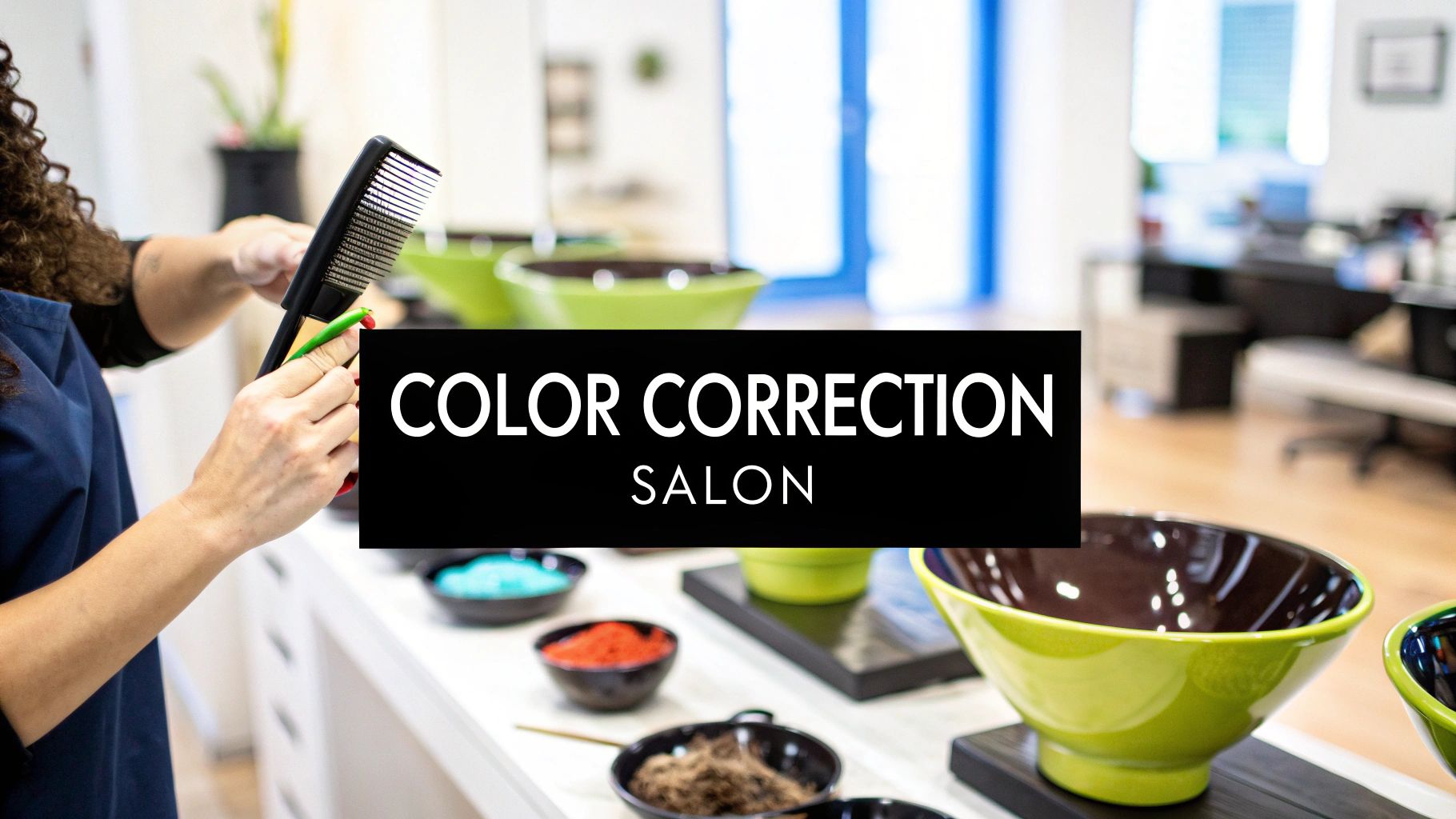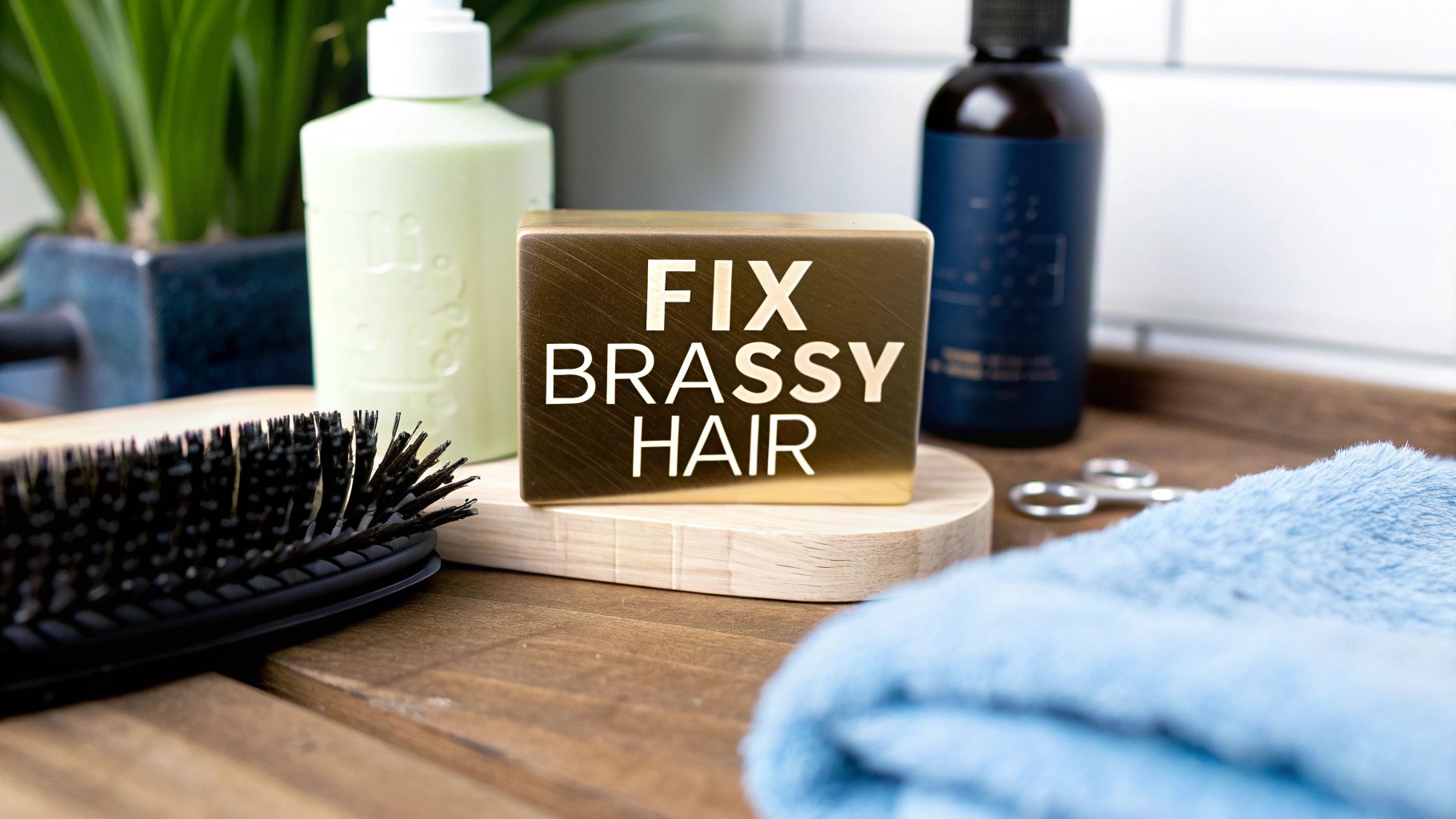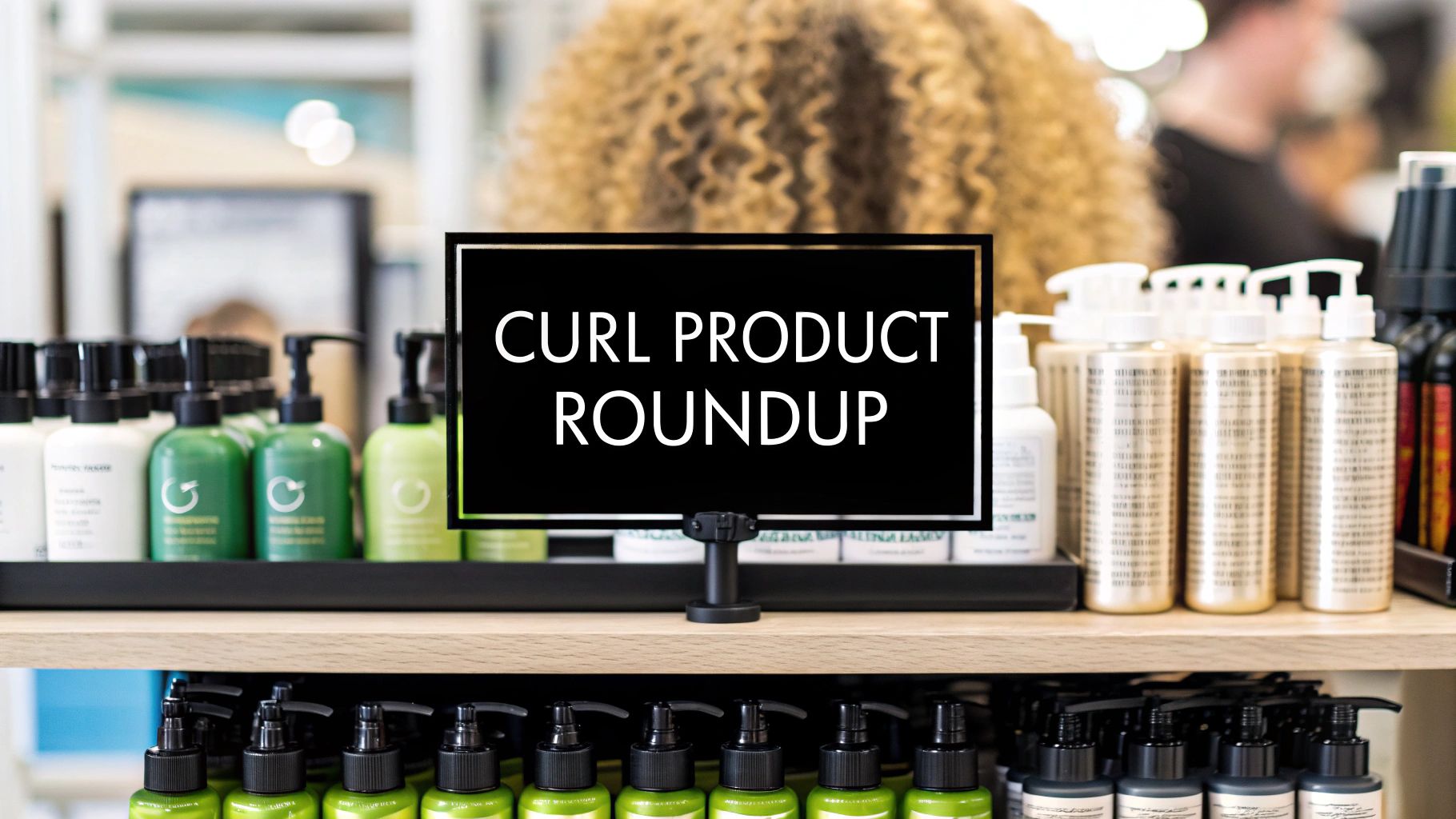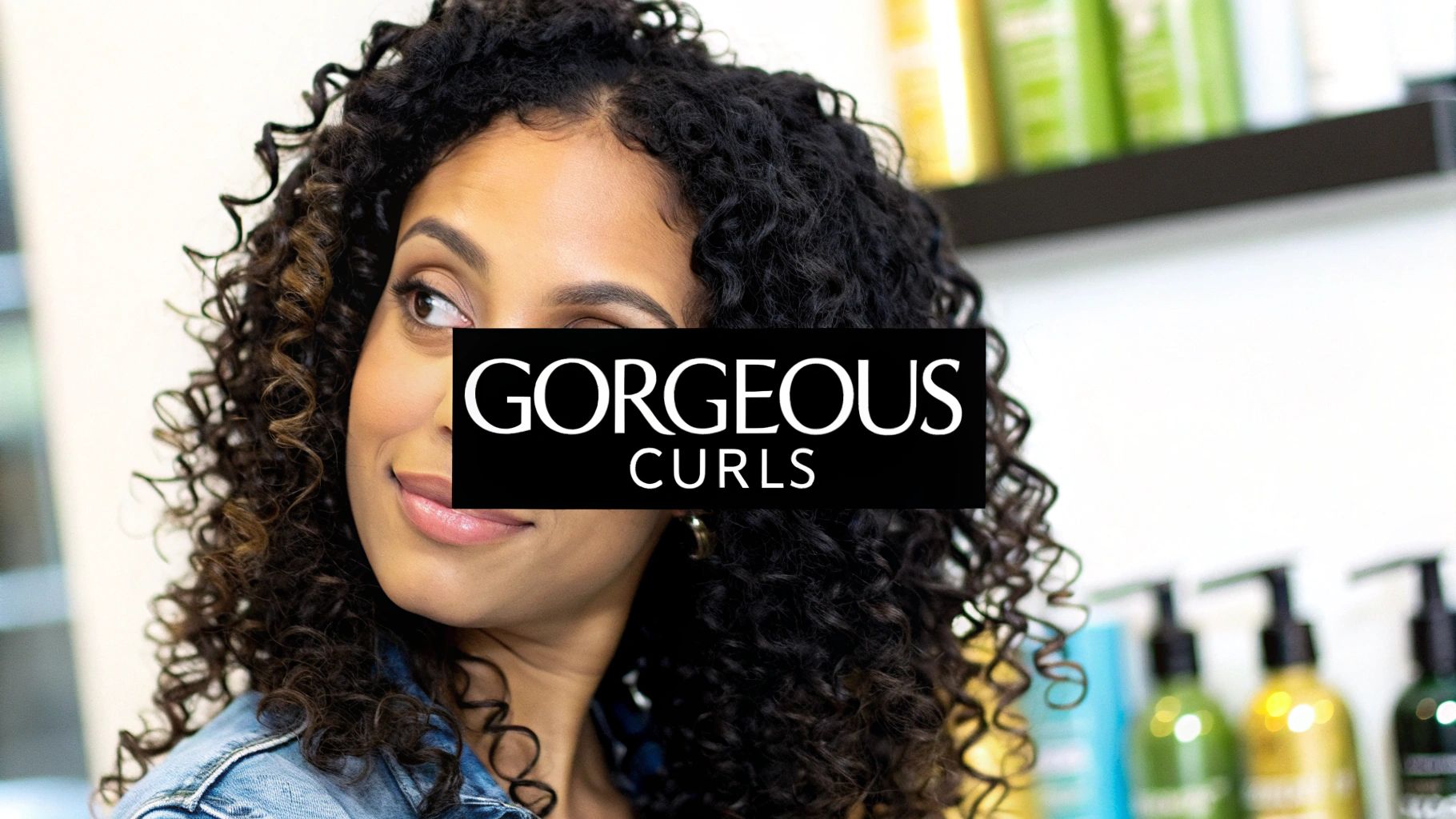When a hair color experiment goes horribly wrong, the panic is real. That frantic search for a "color correction salon near me" is your first, most important step toward getting your hair—and your confidence—back on track.
Thank you for reading this post, don't forget to subscribe!This isn't just about covering up a mistake. Color correction is a highly specialized craft, and you need a true artist to rescue your hair. The right stylist can turn a total disaster into a beautiful, healthy-looking result.
Why Finding the Right Color Correction Salon Matters
After a color mishap, whether it was a DIY box dye that turned your hair orange or a salon visit that left you with patchy streaks, your first instinct might be to grab the quickest, cheapest fix. I've seen it a hundred times, and it almost always makes things worse.
A proper color correction is light-years away from a simple root touch-up or a new set of highlights. It's a complex, multi-step process that blends art with some serious hair chemistry.
The Specialist Difference
Here's how I like to explain it: a regular colorist is like a painter starting with a blank canvas. A color correction specialist, on the other hand, is like a master art restorer meticulously fixing a damaged masterpiece. They aren't just slapping on a new shade; they're carefully undoing what went wrong to create a clean slate, all while keeping your hair's health as the top priority.
This kind of detailed work often involves several stages:
- Lifting the old color: This means gently removing stubborn, unwanted pigment without frying your hair.
- Adding fillers: If your hair has been over-processed, it needs essential pigments put back in to create an even base for the new color.
- Strategic toning: This is where the magic happens. A specialist uses precise formulas to neutralize any brassy, orange, or muddy tones.
A true color correction is never a one-size-fits-all service. It’s a completely custom game plan based on your hair's history, its current condition, and where you want to go with it.
When you choose a salon that truly specializes in corrective work, you're paying for that advanced training and hard-won experience. These stylists understand the intricate science behind fixing blotchy color, removing dark bands, and achieving a seamless result without destroying your hair in the process. It's exactly why the service takes more time and costs more—you're investing in expertise that saves your hair.
How to Find Expert Color Correction Stylists
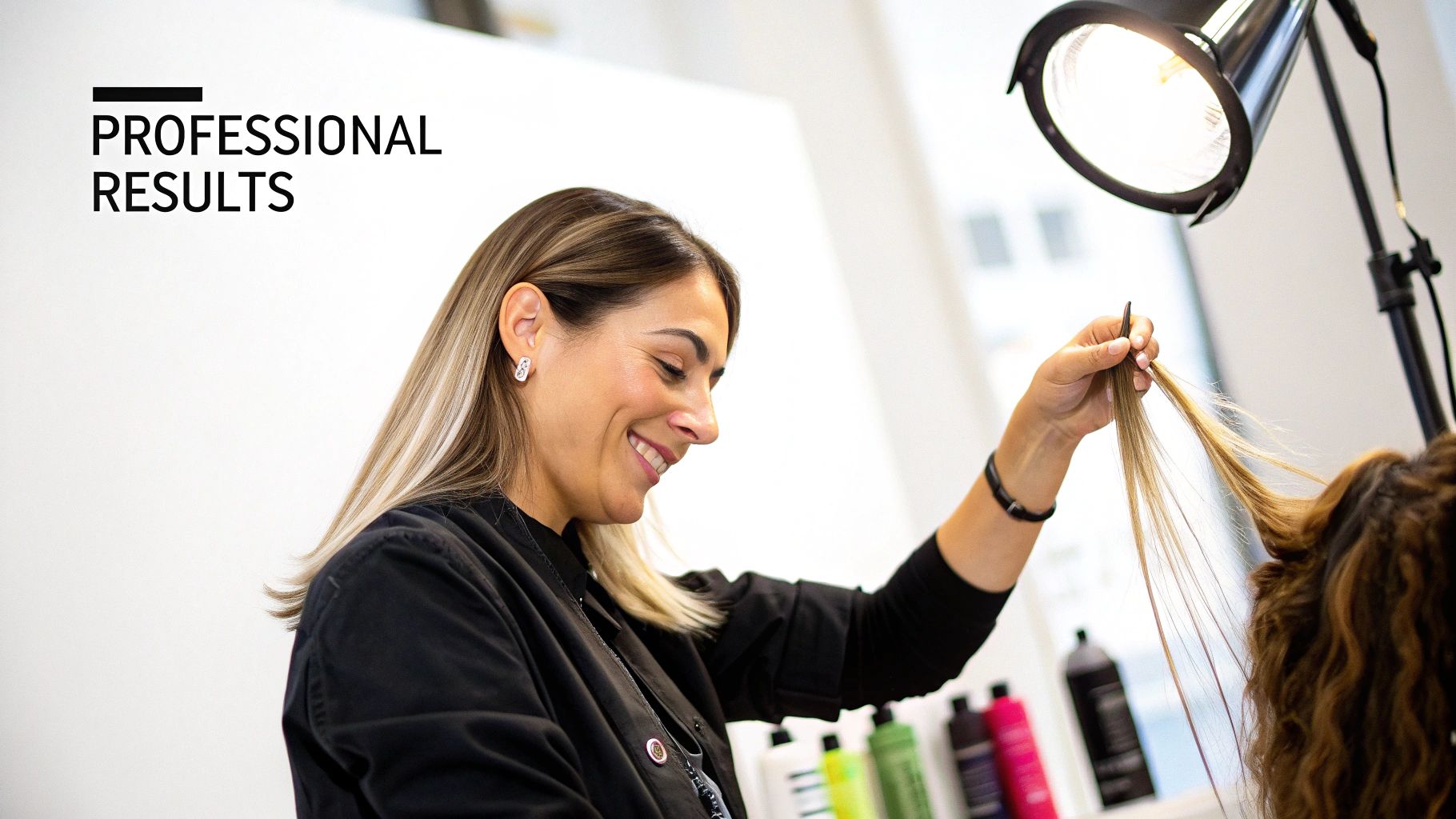
When you’re desperately searching for a "color correction salon near me," you need to dig a lot deeper than you would for a simple trim. This isn't about finding just any stylist; it's about finding a specialist, someone with a portfolio that proves they can tackle the toughest hair color messes.
Your search has to get specific. Forget generic terms like "hair salon." Instead, think like a detective and use phrases that describe your exact problem. Try searching for "hair color correction specialist," "brassy hair fix," or "box dye removal" along with your city. This simple shift will filter out the generalists and point you toward the experts.
And don't forget social media. Instagram is basically a modern-day portfolio for hair artists. Hunt down hashtags like #[yourcity]colorcorrection or #[yourcity]haircolorist. You'll get a real-time look at their work and often discover talented stylists who aren't on the first page of Google.
Analyzing a Stylist's Portfolio
Once you have a shortlist of potential stylists, it’s time to put on your critic's hat. Their portfolio, whether it's on Instagram or a salon website, tells you everything you need to know. Don't be swayed by one amazing "before and after." You're looking for consistency and a gallery full of successful corrections.
Here’s what to zero in on when you're looking at their photos:
- The Story in the Captions: Do they just post a pretty picture, or do they explain the journey? A true color pro will often detail the client's hair history ("we spent 5 hours removing layers of black box dye") and the techniques they used. That's the expertise you want.
- Honest Lighting: Be wary of photos taken under super flattering, dramatic salon lights. The best stylists show their work in consistent, natural lighting so you can see the true tone and quality of the final color.
- Healthy Hair in the "After": The goal is beautiful color and healthy hair. If the "after" shot shows hair that looks fried, frizzy, or dull, that’s a major red flag about their process.
The salon world is booming—the global market is expected to jump from $277.84 billion in 2023 to $297.07 billion in 2024. A huge part of that growth is thanks to technology. With 72% of salons offering online booking, it's never been easier to find and book an appointment with a top-tier specialist. As you vet your options, our guide on how to find a good hair stylist has even more tips to help you choose the right person.
Expert Tip: Don’t just look at the most dramatic transformations. Pay attention to the subtle corrections, like flawlessly toning brassy highlights or seamlessly blending grown-out roots. These fixes require an incredible amount of skill and are a true sign of a master colorist.
Vetting Salons and Mastering the Consultation
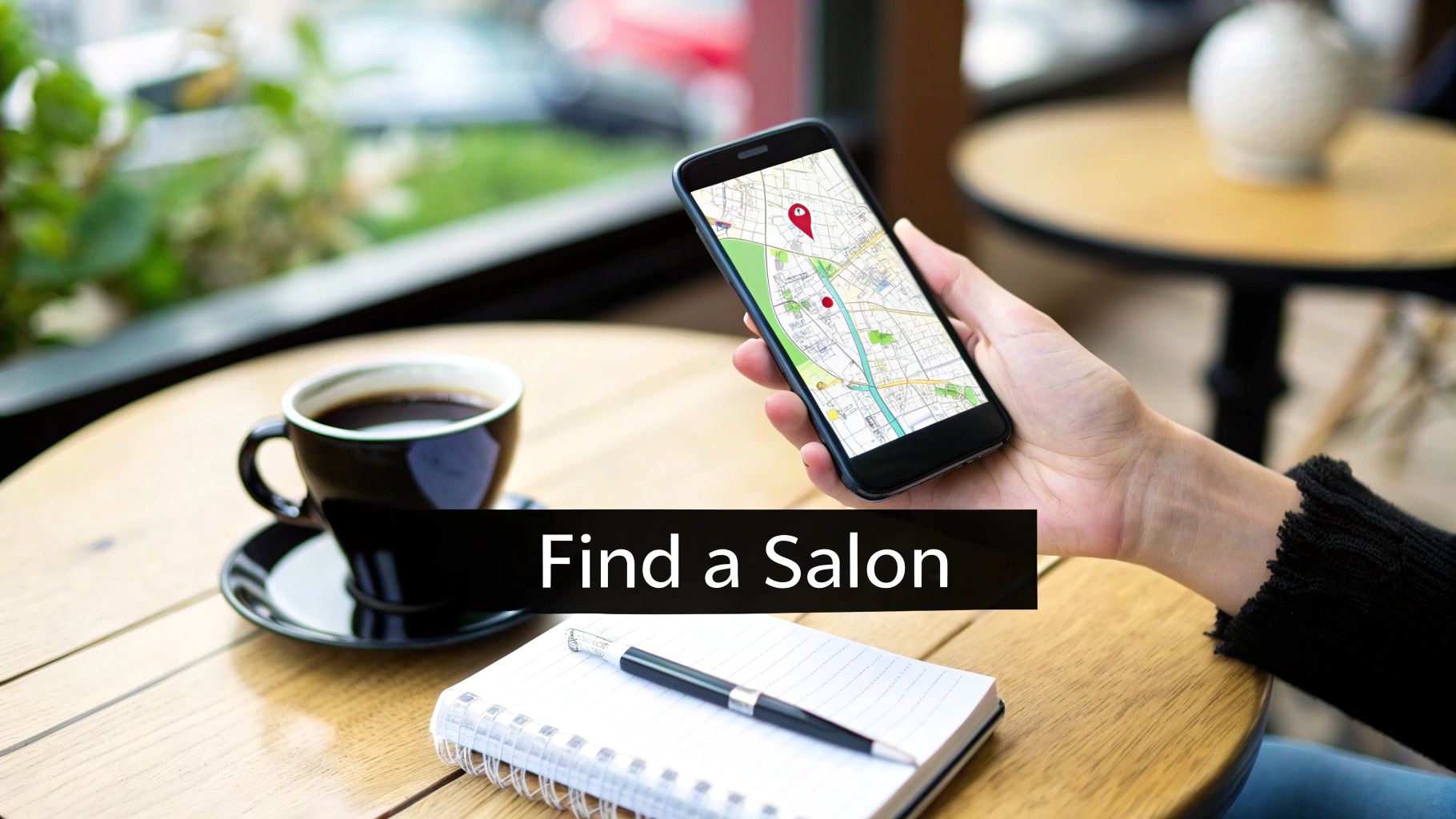
Alright, you’ve got your shortlist of salons. Now comes the most important part of this whole process: the consultation. Think of it less as a simple price check and more like a two-way interview. You're feeling out their expertise, and they're figuring out what’s actually possible with your hair.
Whatever you do, don't skip this meeting. Booking a major color correction without a proper sit-down is a recipe for disaster. A truly skilled stylist will guide the conversation, but you need to show up ready to ask the right questions. This is your chance to see if they have a clear, realistic game plan for you.
Key Questions for Your Stylist
Walk into that salon with a list of questions. Don't be timid about it, either. The way they answer will tell you everything you need to know about their experience and how they approach a challenge like yours.
- “Have you handled a case like mine before?” Come prepared with photos of your current hair situation. Ask to see pictures in their portfolio of corrections that look similar to yours.
- “What’s your realistic plan for my hair?” You want to hear them talk about doing a strand test, potentially using fillers to even out porosity, and the likelihood of multiple sessions. Vague, hand-wavy answers are a major red flag.
- “What’s the total estimated cost?” Ask for a price range that includes everything—the color service, any necessary bond-building treatments, toners, and the final style. Most salons will only quote a price after seeing your hair in person.
- “How many appointments will this realistically take?” This one is huge for managing your own expectations. A dramatic change, like going from black box dye to a clean blonde, will almost always take several visits to protect the integrity of your hair.
A great colorist will be honest, even if it’s not what you want to hear. If they promise a one-session miracle for a complex job, be skeptical. Prioritizing your hair’s health over a quick fix is the sign of a true professional.
To get the most out of your time, bring inspiration photos of your goal color. Just as important, be an open book about your hair's history over the last 2-3 years. They need to know about every box dye, at-home gloss, or keratin treatment. This history is critical for them to create a plan that's both safe and effective.
What Really Happens During a Color Correction
First things first: a color correction appointment isn't your standard trip to the salon. Forget the quick in-and-out visit. This is a marathon, not a sprint, and you should plan on spending several hours—sometimes even the better part of a day—in the chair. Your stylist is embarking on a complex mission to undo unwanted color while keeping your hair as healthy as possible.
The process kicks off with a strand test. This is a non-negotiable step where your stylist tests a small, hidden section of your hair to see exactly how it will react to the color remover or lightener. It’s their roadmap to creating a safe and effective formula just for you. Once they have a game plan, the real work begins. You’ll likely see them mixing different formulas for different parts of your hair to tackle specific problems, like stubborn dark bands or brassy ends.
This process is a methodical journey from start to finish.
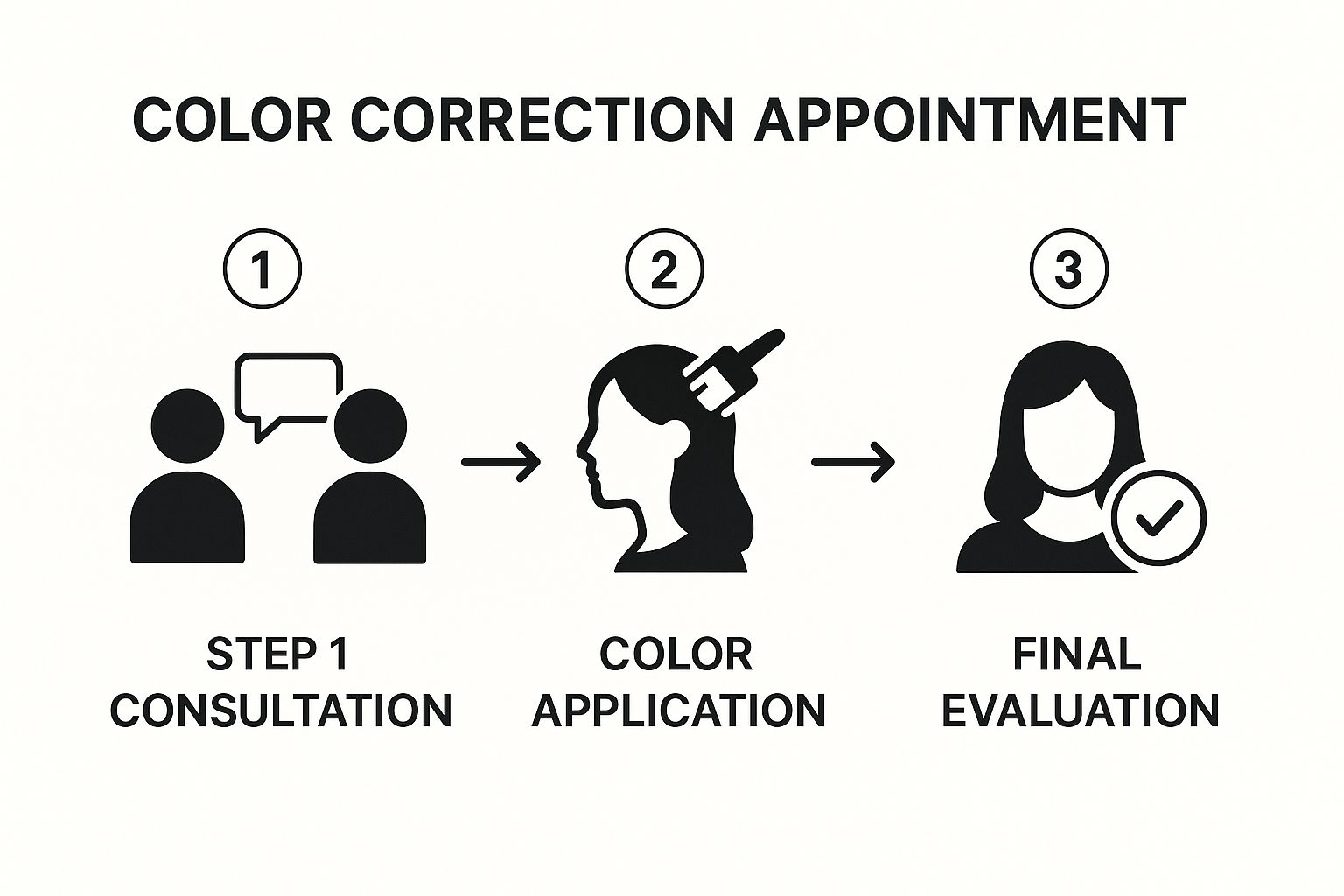
As you can see, it involves careful assessment, precise application, and a final check to make sure everything looks perfect.
To give you a clearer picture, here's a look at what to expect during your multi-hour appointment.
Color Correction Process Expectations
| Stage | What Happens | Typical Duration |
|---|---|---|
| Consultation & Strand Test | Detailed discussion about your hair history and goals. Your stylist tests a small hair sample to plan the formula. | 30 – 60 minutes |
| Corrective Application | The stylist carefully applies color remover, lightener, or other formulas to different sections of your hair as needed. | 1 – 3 hours |
| Processing | Your hair sits with the product on. The stylist will check it frequently to monitor progress. | 30 minutes – 2 hours |
| Toning & Glossing | After rinsing, a toner or gloss is applied to neutralize unwanted tones and add shine. | 20 – 45 minutes |
| Treatment & Styling | A deep conditioning treatment is applied to restore moisture, followed by a final trim, blow-dry, and styling. | 30 – 60 minutes |
Each step is crucial for achieving that beautiful, even color you're looking for.
The Finishing Touches
After the main color work is processed and rinsed, the magic of the toner comes into play. This is what truly refines the new color, cancels out any lingering brassy or muddy tones, and gives your hair that gorgeous, polished shine. We dive deeper into the science behind this at https://hairicc.com/what-is-hair-color-correction/.
To wrap it all up, your stylist will apply a deep conditioning treatment to replenish moisture and strengthen your hair after its long day.
Knowing what to expect from a professional treatment in a salon setting can make the whole experience much more comfortable. Demand for these expert services is a major reason the U.S. beauty market is projected to hit $91.23 billion by 2025, making it the largest in the world. This massive growth shows just how much people value finding the right professional for specialized services like color correction.
Protecting Your Investment After the Salon
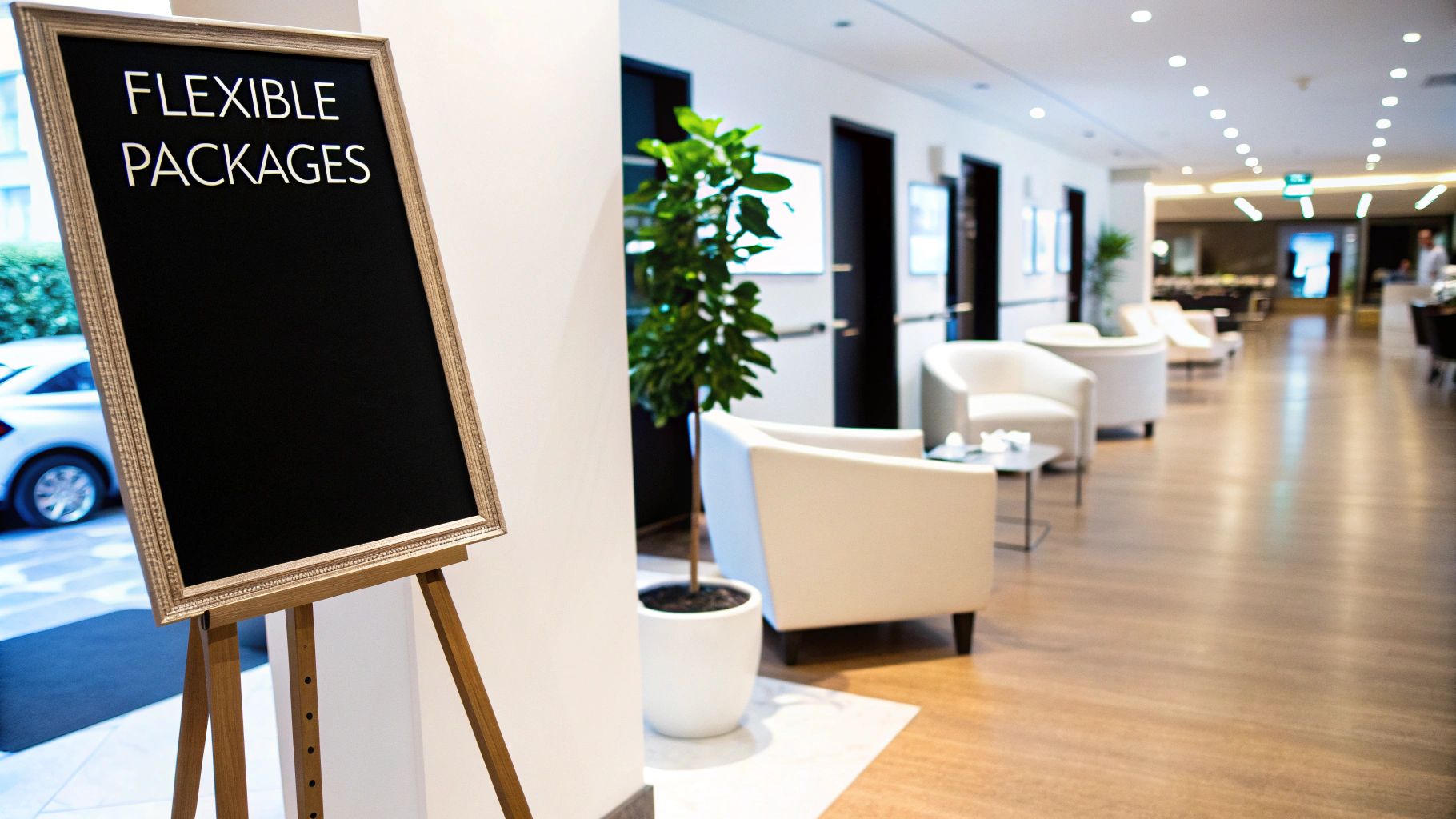
There's nothing like that first look in the mirror after a successful color correction. You leave the salon feeling incredible, and the last thing you want is for that perfect new shade to fade away. The secret to keeping it vibrant? A solid aftercare plan.
First things first: give your hair a break. You need to wait at least 24-48 hours before that first wash. This little bit of patience gives the hair cuticle time to fully close and seal in the new color, which is a critical step people often miss.
After that initial waiting period, it's all about using the right products. Standard shampoos are often loaded with sulfates that can act like a detergent, stripping away your fresh color and undoing all your stylist's hard work. Making the switch to a high-quality, sulfate-free cleanser isn't just a suggestion—it's essential.
Gentle yet effective products, like color-safe shampoo bars, are a fantastic way to clean your hair without compromising the color you just invested in.
Building Your Color-Care Routine
Great aftercare is more than just shampoo. The color correction process can be intense, so your hair will be thirsty for moisture and protein. A good routine focuses on restoring that strength to prevent breakage and keep your color from looking dull.
Here are a few habits to work into your weekly schedule:
- Wash Less Often: One of the quickest ways to lose color is by over-washing. Aim for just 2-3 times per week to keep your shade looking fresh.
- Turn Down the Heat: Hot water is your color's enemy. It opens up the hair cuticle and lets those precious color molecules slip right out. Always try to rinse with lukewarm or cool water.
- Deep Condition Weekly: Think of this as a mini-treatment for your hair. A good deep conditioning mask will restore moisture, boost elasticity, and give your color a rich, luminous look.
- Always Use Heat Protectant: Before you even reach for a blow dryer or straightener, spritz on a quality heat protectant. This creates a barrier that shields your hair from the damaging heat that causes color to fade fast.
Remember, the money you spend on a professional color correction is an investment. Protecting it with the right aftercare products and habits ensures you get to enjoy that beautiful, vibrant color for as long as possible.
The demand for specialized salon services—and the products to maintain them—is a huge reason the global hair salon market was valued at $188.25 billion in 2021 and is expected to hit $216.7 billion by 2025.
If you need some specific product ideas, check out our guide on the https://hairicc.com/best-hair-products-for-color-treated-hair/.
Your Biggest Color Correction Questions, Answered
It's smart to have questions before diving into a major hair appointment. Getting clear on the details is the best way to manage your expectations and feel confident about the process. Let's break down some of the most common things people wonder about when looking for a color correction.
Why Does Color Correction Cost So Much?
That higher price tag is a direct reflection of the incredible amount of skill, time, and product required. This is far from a simple, single-process color.
Your stylist is dedicating several hours (sometimes a full day!) of their focused expertise to your hair. They're mixing multiple, custom bowls of professional-grade lighteners, fillers, and toners, all while strategically using expensive bond-building treatments to keep your hair from breaking. You're not just paying for a hair color; you're investing in a custom-tailored solution from a highly trained specialist.
Can My Hair Be Fixed in One Session?
While everyone hopes for a one-and-done miracle, fixing major color issues in a single visit often isn't realistic or even safe for your hair. This is especially true if we're working through layers of old box dye or making a dramatic change from very dark to very light.
A true professional will always put the health of your hair first, which means they won't rush the process and risk irreversible damage.
Expect your stylist to be upfront about the possibility of multiple appointments. This isn't a sales tactic—it's the mark of an expert who is committed to getting you to your goal color without destroying your hair in the process.
What Is the Difference Between a Toner and a Full Correction?
Think of it as the difference between a quick paint touch-up and a complete home renovation. They serve very different purposes.
- A toner (or gloss) is more of a finishing touch. We use it to cancel out unwanted tones—like that brassy yellow in blonde hair—or to simply add shine and refresh your existing color between bigger appointments. It’s a fast service that refines the shade of your hair.
- A full color correction is a complex, multi-step overhaul. This process involves fundamentally changing your hair's pigment, which could mean stripping out old color, filling in patchy spots to create an even base, and then applying your brand new, desired color.
At Hairicc, our stylists are true masters of complex color transformations. We have the expertise to safely restore your hair's health and integrity while achieving the beautiful results you've been dreaming of. Book your consultation with a Hairicc color specialist today!
